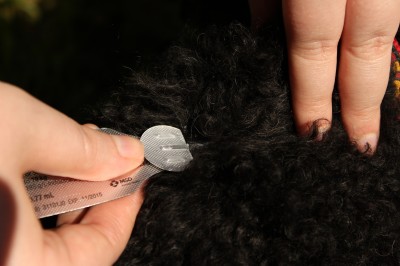
Kylie Baracz discovers the best way to prevent nasty ticks and fleas from affecting your pet this season.
Ticks and fleas are not only bothersome for your dog, making him itchy and irritable; they can also cause serious problems which, when left untreated, can even result in death. Thankfully, both ticks and fleas can easily be prevented.
Ticks
Ticks are parasites that feed on the blood of humans and animals. They inject toxins while feeding that can cause irritation, spread tick-borne diseases and, in the case of Ixodes holocyclus, even cause tick paralysis.
Every year, vets warn that the tick season is upon us and recommend thoroughly checking your dog for these nasty critters.
“Paralysis ticks vary in size depending on how long they have been attached. They vary from a pin point up to one centimetre in length if they are fully engorged,” says Dr Justin Wimpole from the Small Animal Specialist Hospital (SASH). “They are grey to light blue in colour and have eight legs — the middle two pairs are light (almost white) and the end two pairs are dark brown.”
There are many products on the market to help prevent tick attachment and tick paralysis, including collars and topical products.
“Currently, I use Scalibor tick collars on my dog because it is safe and effective and lasts three months,” says Dr Wimpole. “Despite all these fantastic products available, there is no substitute for thorough, regular searches of your pet’s coat. Having your pet’s coat clipped short can also be very helpful as ticks can be hard to find in long fur.”
Dr Wimpole recommends checking your pet’s fur daily for ticks, especially during the heavier tick season (Spring to Autumn). “A tick search involves working your fingers deep into the coat to the skin to check all parts your pet’s skin. Around 70 per cent of ticks are attached on the front half of the pet and they can be in areas like skin folds, or even in ears. Tick searches are much easier if long haired dogs have their coats clipped short for the tick season,” he says.
Removal
If you find a paralysis tick on your dog, it is important to remove it as soon as possible, and check the rest of their coat as well as your other pets’ coats for any ticks.
Dr Wimpole says the best way to remove a tick is with a specific tick remover. There are different types but they are all designed to remove a tick safely and completely.
“You can also use tweezers or long fingernails to grasp the tick where it attaches and twist until it is removed. If the head of the tick is left in the skin, that is not too much of a problem, but it is important not to squeeze the tick too much while it is still attached,” he says.
It is always safest to have your dog checked by your veterinarian if you have found a tick and it is important to remember that signs of tick paralysis can come on after the tick has been removed. If this is the case, they should be seen by your veterinarian immediately.
Tick paralysis signs
Signs of tick paralysis include a change in your dog’s bark, weakness that usually starts in the hind limbs but spreads throughout the body, regurgitating food, water or saliva and noisy, laboured breathing, often with a grunt.
“Recently at SASH we saw a Rottweiler choking on a macadamia nut as an after-hours emergency. This was removed as an emergency endoscopically. The poor dog had suffered some temporary brain injury due to a lack of oxygen while he was choking but he also had a particularly slow recovery and he started to show some weakness and regurgitation. A paralysis tick was found on him and he was treated for tick paralysis and made a full recovery. This is an important reminder that it is important to be aware of the potential for tick paralysis at any time in tick affected areas,” says Dr Wimpole.
If your dog has any sign of tick paralysis, it is vital to get them to see a veterinarian as soon as possible.
Fleas
If you find your dog scratching and nipping at their fur, it is quite likely that your dog has fleas. The majority of the time this can be easily treated, but it’s important to note that symptoms can become quite severe if left untreated.
“Fleas are usually more of an annoying problem for dogs and their owners, but they can also lead to allergies, severe dermatitis, transmission of other parasites and even more serious problems like anaemia,” says Dr Wimpole.
Prevention
To control fleas, it is important to use regular flea control products (top-spots or tablet forms) on all of the pets in the household as well as address the eggs, larvae, pupae and fleas in the home environment. Dr Wimpole says this means regular vacuuming, washing bedding, and drying in sunlight and using products like flea bombs.
Fleas can be detected in the coat by parting the hair and looking for the fleas themselves moving around but also for flea dirt.
“Flea dirt literally looks like flecks of dirt, but because it is digested blood, if it gets wet, it becomes red,” says Dr Wimpole. “To confirm the presence of flea dirt and fleas, you can comb this off the coat onto white paper and wet it to check this. Sometimes fleas can be detected when a dog is having a bath as the water running off them becomes red, and if there is a heavy flea burden, this can be severe.”
Dr Wimpole recommends that if you detect fleas on your dog, use a high-quality product available from your veterinarian such as Activyl or Comfortis.
“Other pets in the household or those your pet is in regular contact with should also be treated,” he says.
Is the tick season getting worse?
Every tick season is terrible, with many dogs and cats affected, some of them severely. But has it become worse?
“Although it is unclear if the tick paralysis problem is worsening, factors that may be leading to this are very mild winters, allowing more ticks to survive the winter, and more fox baiting leading to higher numbers of native tick carriers such as Bandicoots,” says Dr Wimpole. “The geographic distribution of the ticks tends to vary from year to year which can give the impression that the problem is much worse in a given area, even if that is not the case across all affected areas. Similarly, the potency of the ticks can vary from area to area and season to season.”
You need to look after your pooch's health - check out our all-new DOGSLife Directory







Love the tips on preventing ticks as they can be very dangerous. Our dog has never had one because we are very viligilent and check. I have some of my own tips at http://topdogtips.blogspot.com/2016/10/remove-and-prevent-ticks-and-fleas-from-your-dog.html